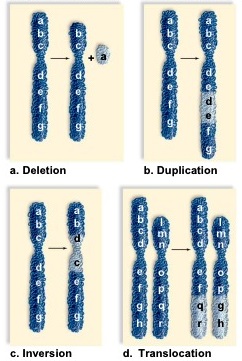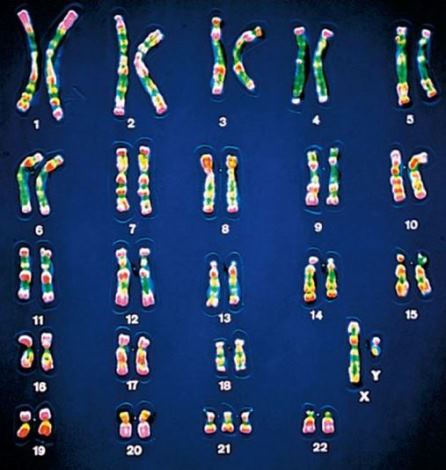Key Concepts
An abrupt, heritable change in genes or chromosomes manifested by changes in the phenotype (appearance) of an organism. The study of mutation has long occupied a central position in genetics. Mutations (Fig. 1) are the ultimate sources of variability upon which evolution acts, despite being random changes that are far more likely to harm than to improve a complicated and highly evolved organism. Laboratory reconstructions have shown that rapidly mutating microbial populations overtake slowly mutating populations when the two are mixed and placed in a new environment to which neither is fully adapted. Mutation has consistently been the most telling probe into the nature of the gene, and the understanding of most aspects of biology has benefited from studies of the properties of mutant organisms. Mutation is also an important component of disease, either causing it directly (for example, through birth defects) or predisposing humans to a vast array of disorders that together constitute a substantial fraction of illnesses. Finally, deliberate selection of mutant plants and animals for economic or aesthetic purposes has long been practiced and has grown into an important aspect of genetics. With advances in molecular genetics, it is now possible to construct specific mutations at will, rather than merely selecting among an array of random mutations for the infrequent useful ones. See also: Animal breeding; Chromosome; Disease; Gene; Genetics; Plant breeding

It is theoretically preferable to define mutations as changes in deoxyribonucleic acid (DNA) sequences, but the classical definition remains the operational definition in most circumstances. Genetic segregation and recombination, however, are not mutational processes, unless aberrant. In addition, it should be noted that the word mutation has two common meanings—one being the process and the other being the product (the altered gene or chromosome carries a mutation). The process is also called mutagenesis. Furthermore, an organism bearing a mutation is called a mutant, whereas an agent that induces a mutation is called a mutagen. See also: Deoxyribonucleic acid (DNA); Mutagens and carcinogens; Recombination (genetics)
Genome or ploidy mutations
The sum of a cell's genes is its genome, and ploidy refers in a general sense to the number of copies of each chromosome in a (nondividing) cell. A cell that has accidentally doubled its number of chromosomes from the normal diploid state (two copies of each chromosome) is called tetraploid; one that has lost a single member of a normal pair is called monosomic; and one that has gained a single member of a normal pair is called trisomic. In higher animals, such changes are usually lethal or severely debilitating; the best-known human example is trisomy for chromosome 21 (Fig. 2), leading to Down syndrome (which occurs at a frequency of roughly 1 per 1000 births). See also: Congenital anomalies; Down syndrome; Polyploidy

Chromosome mutations
Chromosome mutations, which alter sections composed of many DNA base pairs, consist of partial losses (deletions or deficiencies), rearrangements, and additions (Fig. 3). Like genome mutations, most deletions that remove many genes are highly deleterious. Rearrangements may be less deleterious if they shuffle genes about, but do not interrupt them or relocate them to sites where they cannot function well. They involve either inversions (simple reversals of an internal segment of a chromosome) or translocations (transfer of a segment of a chromosome to a new location) [Fig. 1]. Translocations can occur within or between chromosomes, with the latter often occurring reciprocally. Even when not directly deleterious, rearrangements lead to anomalies of genetic recombination; a common secondary consequence in humans is sterility. Addition mutations are of two types, namely, duplications and insertions. Duplications usually consist of tandem repeats of a segment of a chromosome and may range from innocuous to lethal, depending on their location and extent. Insertions occur through the movement of special DNA sequences (transposable elements or transposons) that range from hundreds to thousands of DNA base pairs in length. See also: Chromosome aberration; Transposable elements

Gene mutations
Gene mutations affect only a single gene and consist of intragenic chromosomal mutations, additions or deletions of one or a few base pairs, base-pair substitutions (point mutations), and complex mutations comprising simultaneously arising clusters of any of the above. The severity of a gene mutation depends on its individual nature and on the importance of the affected gene, and it can range from innocuous to lethal.
Because the genetic code employs consecutive sets of three DNA base pairs to specify consecutive amino acids in proteins, the addition or deletion of multiples of three base pairs leads to the addition or deletion of one or more amino acids. However, the addition or deletion of one or two base pairs (or any nonmultiple of three) shifts the reading frame; thus, everything from that point onward is read out of its normal frame, with drastic consequences for that particular gene. These occurrences are called frameshift mutations. See also: Amino acid; Genetic code
Mechanisms
Although important mechanisms of mutagenesis undoubtedly remain to be discovered, many (and perhaps most) of the predominant mechanisms are now known, at least in outline. Genome mutations that alter the number of chromosomes in a cell usually result from the faulty distribution of chromosomes during mitotic or meiotic cell divisions. The fault probably often lies in the systems of spindle fibers that segregate daughter chromosomes into daughter cells; chemicals (for example, colchicine) that interfere with such fibers induce aneuploidy at high frequencies. Chromosome mutations can be formed by chromosome breakage followed by incorrect patterns of rejoining. Many agents, including ionizing radiations and numerous chemicals, can induce chromosome breaks. In addition to events triggered by breaks, deletions and duplications can be triggered by anomalies of genetic recombination between similar (but nonhomologous) DNA sequences. See also: Cell division; Meiosis; Mitosis; Radiation biology
Insertion mutations usually do not arise following random chromosome breaks; instead, they occur through the intrinsic mobility of highly specialized DNA sequences. These transposable elements (transposons) have been found to be a major factor in spontaneous mutagenesis because their transposition into a gene is very likely to inactivate that gene. They seem to play a minor role in induced mutagenesis.
Cause and prevention
Cells direct a number of repair operations against anomalies of DNA structure that would otherwise result in death or mutation. Although some of these repair mechanisms circumvent death, others actually cause mutations. Most DNA damage is detected by excision repair systems before it can interfere with replication. These systems enzymatically remove the damaged bases and their associated sugar-phosphate backbones; the resulting gap is then filled in by DNA repair synthesis, using the complementary strand as a template. However, occasional damaged or transitorily rearranged bases enter the DNA replication fork, where they encounter DNA polymerase (the enzyme responsible for DNA synthesis). Most DNA polymerases are able to discriminate against base mispairs, although this process is still poorly understood. Still, even when a mispaired base has been covalently incorporated, it is often removed. This enzymatic activity is called proofreading. See also: DNA repair; Enzyme
Future research
With the recognition that many chemicals are mutagenic and that many humans (possibly 5–25%, depending on the criteria used) suffer from mutations of ancient or recent origin, much attention has been directed to discovering the mutagenic components of the environment. Many artificial chemicals are mutagenic; in addition, as a part of their ongoing war against predators, most plants elaborate (produce) chemicals that are mutagenic for at least some organisms. The effect of these exposures is largely unassessed, but intensive ongoing research is likely to provide some concrete answers.
Although the search for ways to prevent unwanted mutation continues vigorously, other searches seek methods to introduce specific, predetermined, desirable mutations into organisms of economic importance. By using the methods of molecular genetics, it is now usually possible to introduce specific mutations into specific genes in order, for instance, to increase the production of some marketable product. However, this step requires considerable prior knowledge about the organism's genetic and biochemical makeup. A more distant possibility is intervention in the human germline in order, for instance, to cure specific genetic diseases. See also: Genetic engineering; Human genetics





